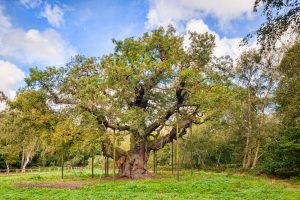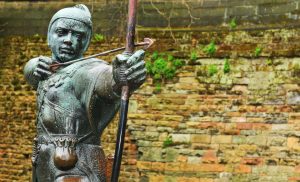 https://www.wilsontreesurgery.com/wp-content/uploads/2024/09/20230807_162313-500x375.jpg
https://www.wilsontreesurgery.com/wp-content/uploads/2024/09/20230807_162313-500x375.jpg
Machinery used in utility arboriculture
Read more
by Wilson Tree Surgery |
Located In the heart of Sherwood Forest is the Major Oak, famous through art, poetry, and most famously through the legendary tales of Robin Hood.
Believed to be over 800 years old, The Major Oak is massive – with a girth of over 33 feet (10 metres). Its size speaks volumes about the centuries it has weathered, standing firm through countless seasons, storms, and historical events.

Perhaps the most famous aspect of the Major Oak is its connection to the legendary outlaw, Robin Hood. According to local folklore, the hollow interior of the tree served as a hideout for Robin Hood and his band of Merry Men as they outwitted the Sheriff of Nottingham and fought for justice in mediaeval England. While the historical accuracy of these tales may be debated, the allure of the Major Oak as a symbol of resistance against oppression remains undiminished.

Because of the cultural and ecological significance of the Major Oak, conservation efforts have been undertaken to protect the tree. Elaborate supports have been installed to prevent its ancient branches from succumbing to their own weight, allowing visitors to marvel at its majestic form while ensuring its long-term survival. Sherwood Forest and the Major Oak are protected as a National Nature Reserve, safeguarding the site for generations to come.
Beyond its historical and environmental importance, the Major Oak serves as a source of inspiration for artists, writers, and nature enthusiasts alike. It has been immortalised in countless works of literature, poetry, and art, drawing visitors from around the world.
To visit Major Oak and Sherwood Forest, head to Nottinghamshire for a guided walks, interpretive exhibits, and interactive experiences. Visitors are given the opportunity to delve deeper into the history, ecology, and folklore of this legendary woodland.
 https://www.wilsontreesurgery.com/wp-content/uploads/2024/09/20230807_162313-500x375.jpg
https://www.wilsontreesurgery.com/wp-content/uploads/2024/09/20230807_162313-500x375.jpg
Read more
 https://www.wilsontreesurgery.com/wp-content/uploads/2024/09/AdobeStock_475873508-500x333.jpeg
https://www.wilsontreesurgery.com/wp-content/uploads/2024/09/AdobeStock_475873508-500x333.jpeg
Read more
 https://www.wilsontreesurgery.com/wp-content/uploads/2024/09/pexels-valiphotos-589802-500x333.jpg
https://www.wilsontreesurgery.com/wp-content/uploads/2024/09/pexels-valiphotos-589802-500x333.jpg
Read more